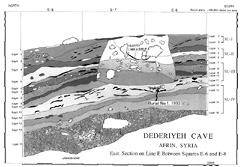
Click on the image to enlarge it. |
The stratigraphic sequence of the east section.
It shows the position of the first Dederiyeh Neanderthal (Burial No. 1) uncovered in situ in Layer 11 in 1993. Burial No. 1 was found directly beneath the flat bottom of the pit. This pit, circular in outline, was about 2.5 m in diameter and 1.5 m in depth with a hard, flat bottom dug down to Layer 11. The collection of the pit was not homogeneous. It contained two major archaeological elements, large quantities of abraded and broken flints of Middle Paleolithic character, and many pottery fragments assigned to the Late Aramean period dating to about the 6-7th centuries BC. The Middle Paleolithic deposits had been dug out in order to make the construction, but the function of the construction has not been determined yet. The presence of a large hearth dated to 1960 50 BP (TK-946) in the uppermost layer of the pit demonstrates that the pit was reused by the second coming inhabitants afterward (from Akazawa et al., 2003: Fig. I-2). 50 BP (TK-946) in the uppermost layer of the pit demonstrates that the pit was reused by the second coming inhabitants afterward (from Akazawa et al., 2003: Fig. I-2). |
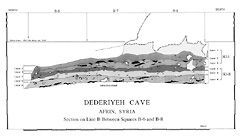
Click on the image to enlarge it. |
The stratigraphic sequence of the east section.
The stratigraphic sequence of the east section of Squares B-6 through B-8. It shows earth-moving operations of the uppermost deposit (Layer 1). Layers 3 and 6 contain numerous Middle Paleolithic fire rings (from Akazawa et al., 2003: Fig. I-3). |
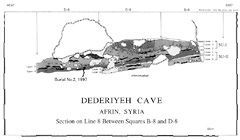
Click on the image to enlarge it. |
The stratigraphic sequence of the north section.
The stratigraphic sequence of the north section of Squares B-8 through D-8. It shows the position of the second Dederiyeh Neanderthal (Burial No. 2) uncovered in Layer 3 in 1997 (from Akazawa et al., 2003: Fig. I-4). |
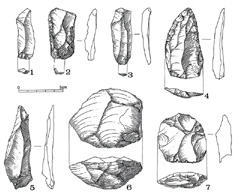
Click on the image to enlarge it. |
Representative pieces of the Middle Paleolithic flints of the fourth stratigraphic unit (SU-IV).
(From Akazawa et al., 2003: Fig. I-5.)
- Use-retouch Levallois blade with bi-directional preparation scars (Layer 12)
- Double straight side-scraper with uni-directional preparation scars (Layer 13)
- Use-retouch Levallois blade with uni-directional preparation scars (Layer 13)
- Use-retouch Levallois blade with bi-directional preparation scars (Layer 12)
- Convergent side-scraper with uni-directional preparation scars (Layer 14)
- Levallois point core with uni-directional preparation scars (Layer 13)
- Discoidal core with uni-facial flaking scars (Layer 12)
|
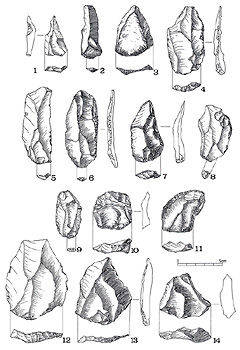
Click on the image to enlarge it. |
Representative pieces of the Middle Paleolithic flints of the third stratigraphic unit (SU-III).
(From Akazawa et al., 2003: Fig. I-6.)
- Notched piece on a Levallois point (Layer 10)
- Use-retouch Levallois blade with uni-directional preparation scars (Layer 10)
- Use-retouch Levallois point with uni-directional preparation scars (Layer 11)
- Convex side-scraper on a Levallois flake with multi-directional preparation scars (Layer 10)
- Use-retouch Levallois blade with bi-directional preparation scars (Layer 10)
- Backed piece on a Levallois blade with bi-directional preparation scars (Layer 11)
- Use-retouch Levallois point with bi-directional preparation scars (Layer 10)
- Convex side-scraper on a cortical flake (Layer 11)
- Cortical flake with use-retouch (Layer 11)
- Levallois flake core with multi-directional preparation scars (Layer 10)
- Convex side-scraper on a cortical flake (Layer 11)
- Use-retouch Levallois flake with multi-directional preparation scars (Layer 10)
- Use-retouch Levallois point with uni-directional preparation scars (Layer 10)
- Levallois point core with uni-directional preparation scars (Layer 11)
|
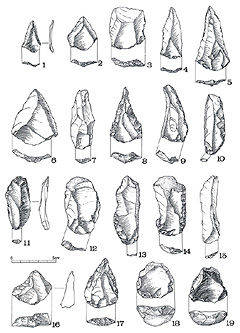
Click on the image to enlarge it. |
Representative pieces of the Middle Paleolithic flints of the third stratigraphic unit (SU-III).
(From Akazawa et al., 2003: Fig. I-7.)
- Use-retouch Levallois point with uni-directional preparation scars (Layer 8)
- Use-retouch Levallois point with uni-directional preparation scars (Layer 9)
- Use-retouch Levallois flake with bi-directional preparation scars (Layer 9)
- Use-retouch Levallois point with uni-directional preparation scars (Layer 9)
- Use-retouch Levallois point with bi-directional preparation scars (Layer 9)
- Use-retouch Levallois point with uni-directional preparation scars (Layer 7)
- Use-retouch Levallois blade with multi-directional preparation scars (Layer 7)
- Mousterian point (Layer 9)
- Cortical flake with use-retouch (Layer 9)
- Convex side-scraper on a cortical flake (Layer 7)
- End-scraper on a Levallois blade with bi-directional preparation scars (Layer 8)
- Cortical flake with use-retouch (Layer 7)
- Convex side-scraper on a cortical blade (Layer 8)
- Straight side-scraper on a cortical flake (Layer 8)
- Use-retouch Levallois blade with uni-directional preparation scars (Layer 9)
- Concave side-scraper on a Levallois point flake core (Layer 9)
- Mousterian point (Layer 7)
- Levallois flake core with multi-directional preparation scars (Layer 7)
- Levallois point core with multi-directional preparation scars (Layer 8)
|
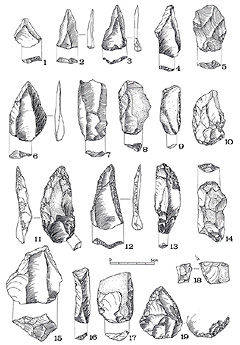
Click on the image to enlarge it. |
Representative pieces of the Middle Paleolithic flints of the second stratigraphic unit (SU-II).
(From Akazawa et al., 2003: Fig. I-8.)
- Use-retouch Levallois point with uni-directional preparation scars (Layer 5)
- Use-retouch Levallois point with uni-directional preparation scars (Layer 6)
- Use-retouch Levallois point with uni-directional preparation scars (Layer 5)
- Use-retouch Levallois point with bi-directional preparation scars (Layer 6)
- Use-retouch Levallois flake with multi-directional preparation scars (Layer 6)
- Use-retouch Levallois point with uni-directional preparation scars (Layer 6)
- Use-retouch Levallois blade with bi-directional preparation scars (Layer 5)
- Straight side-scraper on a cortical flake (Layer 6)
- Non-Levallois blade with use-retouch (Layer 4)
- Convex side-scraper on a cortical flake (Layer 5)
- Convergent scraper on a cortical flake (Layer 6)
- Mousterian point (Layer 6)
- Convex side-scraper on a non-Levallois blade (Layer 4)
- End-scraper on a cortical flake (Layer 5)
- Levallois blade core with multi-directional preparation scars (Layer 5)
- Use-retouch Levallois blade with bi-directional preparation scars (Layer 6)
- Straight side-scraper on a cortical flake (Layer 5)
- Burin on a cortical flake (Layer 5)
- Retouched point on a truncated faceted Levallois flake with multi-directional preparation scars (Layer 5)
|
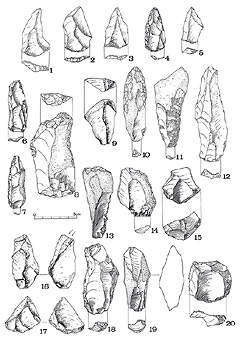
Click on the image to enlarge it. |
Representative pieces of the Middle Paleolithic flints of the first stratigraphic unit (SU-I).
(From Akazawa et al., 2003: Fig. I-9.)
- Use-retouch Levallois flake with uni-directional preparation scars (Layer 3)
- Use-retouch Levallois flake with multi-directional preparation scars (Layer 3)
- Use-retouch Levallois point with uni-directional preparation scars (Layer 1)
- Retouched Levallois point with multi-directional preparation scars (Layer 3)
- Use-retouch Levallois point with bi-directional preparation scars (Layer 1)
- Use-retouch non-Levallois blade with multi-directional preparation scars (Layer 3)
- Convex side-scraper on a cortical blade (Layer 3)
- End-scraper on a cortical flake (Layer 1)
- End-scraper on a non-Levallois flake (Layer 1)
- Convergent scraper on a cortical flake (Layer 1)
- Concave side-scraper on a cortical flake (Layer 1)
- Use-retouch non-Levallois blade with uni-directional preparation scars (Layer 1)
- End-scraper on a cortical flake (Layer 1)
- Backed piece on a cortical flake (Layer 1)
- Levallois point core with bi-directional preparation scars (Layer 1)
- Dihedral burin on a non-Levallois flake (Layer 1)
- Truncated faceted Levallois point (Layer 1)
- Use-retouch non-Levallois flake with multi-directional preparation scars (Layer 1)
- Naviform type core with bi-directinal flaking scars (Layer 1)
- Levallois flake core with multi-directional preparation scars (Layer 1)
|
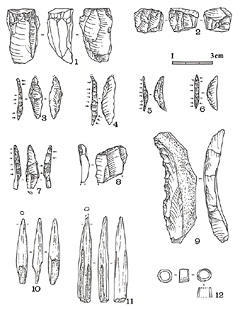
Click on the image to enlarge it. |
Representative pieces of the Natufian assemblages of the Dederiyeh Cave.
(From Akazawa et al., 2003: Fig. I-10.)
- Blade core
- Blade core
- Lunate
- Lunate
- Lunate
- Lunate
- Perforator
- End-scraper
- Denticulate
- Bone point
- Bone point
- Bone bead
| |